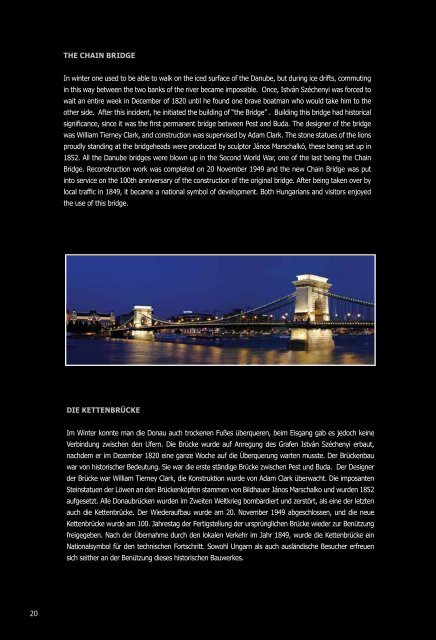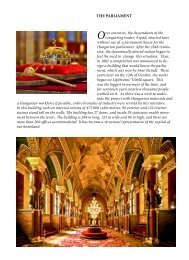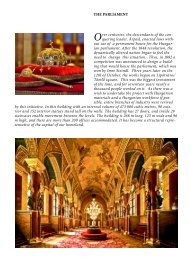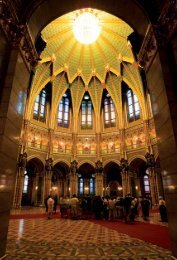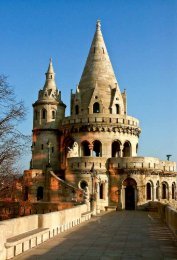BP_small_portrait
You also want an ePaper? Increase the reach of your titles
YUMPU automatically turns print PDFs into web optimized ePapers that Google loves.
w<br />
THE CHAIN BRIDGE<br />
In winter one used to be able to walk on the iced surface of the Danube, but during ice drifts, commuting<br />
in this way between the two banks of the river became impossible. Once, István Széchenyi was forced to<br />
wait an entire week in December of 1820 until he found one brave boatman who would take him to the<br />
other side. After this incident, he initiated the building of “the Bridge” . Building this bridge had historical<br />
significance, since it was the first permanent bridge between Pest and Buda. The designer of the bridge<br />
was William Tierney Clark, and construction was supervised by Adam Clark. The stone statues of the lions<br />
proudly standing at the bridgeheads were produced by sculptor János Marschalkó, these being set up in<br />
1852. All the Danube bridges were blown up in the Second World War, one of the last being the Chain<br />
Bridge. Reconstruction work was completed on 20 November 1949 and the new Chain Bridge was put<br />
into service on the 100th anniversary of the construction of the original bridge. After being taken over by<br />
local traffic in 1849, it became a national symbol of development. Both Hungarians and visitors enjoyed<br />
the use of this bridge.<br />
DIE KETTENBRÜCKE<br />
Im Winter konnte man die Donau auch trockenen Fußes überqueren, beim Eisgang gab es jedoch keine<br />
Verbindung zwischen den Ufern. Die Brücke wurde auf Anregung des Grafen István Széchenyi erbaut,<br />
nachdem er im Dezember 1820 eine ganze Woche auf die Überquerung warten musste. Der Brückenbau<br />
war von historischer Bedeutung. Sie war die erste ständige Brücke zwischen Pest und Buda. Der Designer<br />
der Brücke war William Tierney Clark, die Konstruktion wurde von Adam Clark überwacht. Die imposanten<br />
Steinstatuen der Löwen an den Brückenköpfen stammen von Bildhauer János Marschalko und wurden 1852<br />
aufgesetzt. Alle Donaubrücken wurden im Zweiten Weltkrieg bombardiert und zerstört, als eine der letzten<br />
auch die Kettenbrücke. Der Wiederaufbau wurde am 20. November 1949 abgeschlossen, und die neue<br />
Kettenbrücke wurde am 100. Jahrestag der Fertigstellung der ursprünglichen Brücke wieder zur Benützung<br />
freigegeben. Nach der Übernahme durch den lokalen Verkehr im Jahr 1849, wurde die Kettenbrücke ein<br />
Nationalsymbol für den technischen Fortschritt. Sowohl Ungarn als auch ausländische Besucher erfreuen<br />
sich seither an der Benützung dieses historischen Bauwerkes.<br />
20


